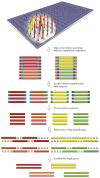DNA synthesis, assembly and applications in synthetic biology
- PMID: 22633067
- PMCID: PMC3424320
- DOI: 10.1016/j.cbpa.2012.05.001
DNA synthesis, assembly and applications in synthetic biology
Abstract
The past couple of years saw exciting new developments in microchip-based gene synthesis technologies. Such technologies hold the potential for significantly increasing the throughput and decreasing the cost of gene synthesis. Together with more efficient enzymatic error correction and genome assembly methods, these new technologies are pushing the field of synthetic biology to a higher level.
Copyright © 2012 Elsevier Ltd. All rights reserved.
Figures




References
-
- Caruthers MH, Barone AD, Beaucage SL, Dodds DR, Fisher EF, McBride LJ, Matteucci M, Stabinsky Z, Tang JY. Chemical synthesis of deoxyoligonucleotides by the phosphoramidite method. Methods Enzymol. 1987;154:287–313. - PubMed
-
- Caruthers MH. Gene synthesis machines: DNA chemistry and its uses. Science. 1985;230:281–285. - PubMed
-
- Stemmer WP, Crameri A, Ha KD, Brennan TM, Heyneker HL. Single-step assembly of a gene and entire plasmid from large numbers of oligodeoxyribonucleotides. Gene. 1995;164:49–53. - PubMed
-
- Au LC, Yang FY, Yang WJ, Lo SH, Kao CF. Gene synthesis by a LCR-based approach: high-level production of leptin-L54 using synthetic gene in Escherichia coli. Biochem Biophys Res Commun. 1998;248:200–203. - PubMed
Publication types
MeSH terms
Substances
Grants and funding
LinkOut - more resources
Full Text Sources
Other Literature Sources
Miscellaneous

